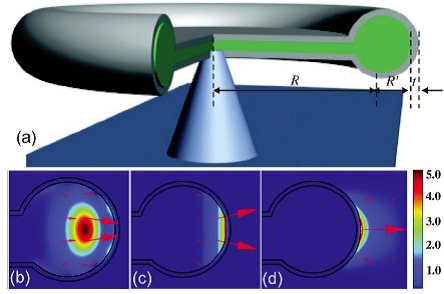Optical whispering gallery mode can concentrate on the exterior surface of microresonator
Time:2011-04-08ClickTimes:
Researchers with Peking University and University of Science and Technology of China have found a novel kind of whispering gallery modes in a metal-coated microresonator system. These modes not only possess high quality factors at room temperature but also are highly localized on the exterior surface of the microresonator. Prof. Yun-Feng Xiao and Prof. Qihuang Gong led this collaborative research. This work is reported in the October 8, 2010 edition of the journal Physical Review Letters. The paper is entitled: "High-Q exterior whispering-gallery modes in a metal-coated microresonator."
About 100 years ago, Lord Rayleigh discovered that if two people stood at opposite sides of the whispering gallery located in the dome of St. Paul’s Cathedral, at a distance of 42 meters, and one whispered into the wall of the dome, then the other person could hear what was being said. The reason for this interesting effect is that the sound bounces along the wall of the gallery with very little loss, and so it can be heard at a great distance. This is known as a 'whispering gallery mode' in honor of the gallery where it was discovered. In recent years whispering gallery modes have found new fame with the development of nano/micro-photonics. In the modern version of this effect, light is made to bounce around the edge of a glass sphere or toroid, known as total reflection. Optical whispering-gallery microresonators provide a powerful platform for various photonic applications ranging from low-threshold lasing to highly sensitive bio/chemical sensing. They are also used for fundamental studies including cavity opto-mechanics, cavity quantum electrodynamics and quantum information science in the past few years.

|
The whispering gallery located in the dome of St. Paul’s Cathedral
|
Optical whispering gallery modes are dominantly confined in the high-refraction-index dielectric material, i.e., the inside of the cavity body. The remaining energy of the WG mode is stored in the weak exterior evanescent field with a characteristic length of tens to hundreds of nanometers. The evanescent field is of importance because it not only offers an effective pathway to exchange the energy between the cavity mode and outside, but also holds important applications that lie on the evanescent field. For instance, the resonant wavelength of the whispering gallery mode is sensitive to the refractive index change induced by the binding of biological or chemical molecules to the resonator surface. Thus, whispering gallery microresonators can be used for highly sensitive detection of single biological or chemical molecules, which has attracted much attention very recently. Nevertheless, the detection sensitivity is strongly limited by the weak exterior evanescent field. In this work, they investigate a metal-coated silica microcavity in detail. It is found that this hybrid system supports not only conventional optical and interior plasmonic whispering gallery modes, but also a novel kind of exterior plasmonic whispering gallery modes. The new modes are concentrated in the exterior surface of the coated microcavity. Assisted by the propagating surface plasmon, these exterior modes show a high localization and reasonable high quality factors.
Moreover, they have demonstrated that the exterior whispering gallery modes can be efficiently excited by a tapered fiber. The coupling between interior and exterior modes is also investigated. Interestingly, this coupling not only produces a strong anti-crossing, but also forms a long-lived anti-symmetric mode. These exterior modes are compatible with micro-fluidics and thus hold great potential for various applications, e.g., highly sensitive biosensors.

|
(a) Schematic illustration of a metal-coated silica toroidal microcavity supported by a silicon
pillar. (b)-(d) False-color representations of the squared transverse electric fields for
conventional optical, interior and exterior plasmonic whispering gallery modes, respectively.
|
